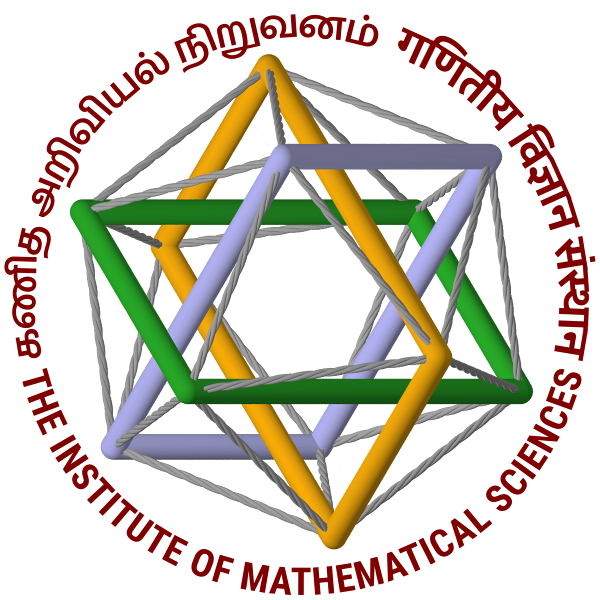A national institute for research in the theoretical sciences
Seminars
Nov 03
11:30-13:00
11:30-13:00
Dr. Aditya Nema | IIT Gandhinagar
TCS Seminar | Alladi Ramakrishnan Hall
Nov 03
14:00-15:00
14:00-15:00
Soumyadip Sarkar | IMSc
Mathematics Seminar | Room 326
Nov 03
14:00-15:00
14:00-15:00
Surajit Kalita | Astronomical Observatory, University of Warsaw, Poland
Physics Seminar | Alladi Ramakrishnan Hall
Nov 04
14:00-15:00
14:00-15:00
Biswajit Sahoo | King's College London
Physics Seminar | Alladi Ramakrishnan Hall
Nov 05
14:00-15:00
14:00-15:00
Supratim Das Bakshi | Argonne National Laboratory, Chicago, IL, USA
Physics Seminar | Alladi Ramakrishnan Hall
Nov 05
15:30-17:00
15:30-17:00
Saket+ | IMSc
Parameterized Complexity Seminar
TCS Seminar | E C G Sudarshan Hall
Nov 06
10:00-11:00
10:00-11:00
Karthik C S | Department of Computer Science, Rutgers University
TCS Seminar | Alladi Ramakrishnan Hall
Nov 06
14:00-15:00
14:00-15:00
Sagar Kalane | IMSc
Mathematics Colloquium | Room 326
Nov 06
14:00-15:00
14:00-15:00
Rome Samanta | SSM, INFN Naples, Italy
Physics Seminar | Alladi Ramakrishnan Hall
Nov 06
15:30-16:30
15:30-16:30
Arnab Kundu | Simion Stoilow Institute of Mathematics of the Romanian Academy
Mathematics Colloquium | Alladi Ramakrishnan Hall
Nov 07
10:00-11:30
10:00-11:30
Saket+Graph Theory Seminar
TCS Seminar | Alladi Ramakrishnan Hall
Nov 07
14:00-15:00
14:00-15:00
Satyajit Seth | Physical Research Laboratory, Ahmedabad
Physics Seminar | Alladi Ramakrishnan Hall
Nov 10
03:30-05:00
03:30-05:00
Suman Mondal | IISER Thiruvananthapuram
Mathematics Seminar | Alladi Ramakrishnan Hall
Nov 10
14:00-15:00
14:00-15:00
Rishav Roshan | University of Southampton
Physics Seminar | Alladi Ramakrishnan Hall
Nov 11
14:00-15:00
14:00-15:00
Pratik Rath | University of California, Berkeley
Physics Seminar | Alladi Ramakrishnan Hall
Nov 11
15:30-16:45
15:30-16:45
Robin Kehr | University of Giessen
Physics Seminar | Alladi Ramakrishnan Hall
Nov 12
14:00-15:00
14:00-15:00
Ushak Rahaman | University of Toronto
Physics Seminar | Alladi Ramakrishnan Hall
Nov 12
15:30-17:00
15:30-17:00
Saket+ | IMSc
Parameterized Complexity Seminar
TCS Seminar | E C G Sudarshan Hall
Nov 12
15:30-17:00
15:30-17:00
Abhishek Mohapatra | TU Munich
Physics Seminar | Alladi Ramakrishnan Hall
Nov 13
14:00-15:00
14:00-15:00
Jacky Kumar | Physical Research Laboratory, Ahmedabad
Physics Seminar | Alladi Ramakrishnan Hall
Nov 14
10:00-11:30
10:00-11:30
Saket+Graph Theory Seminar
TCS Seminar | Alladi Ramakrishnan Hall
Nov 14
14:30-15:30
14:30-15:30
Andres Stump | HU Berlin
Physics Seminar | E C G Sudarshan Hall
Nov 14
15:15-17:30
15:15-17:30
Leonard CadilhacNot yet decide
Mathematics Seminar | Alladi Ramakrishnan Hall
Nov 14
15:30-17:00
15:30-17:00
Sougata Bose | Univ of Mons
TBA
TCS Seminar | E C G Sudarshan Hall
